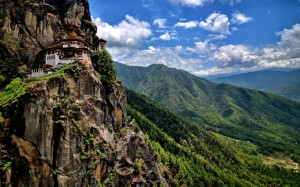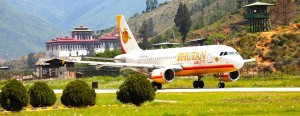
5 reasons Bhutan is worth the US$250 daily fee
Bhutan’s strategy of “low volume, high quality” tourism has made it a highly regarded destination among discerning travelers.
It costs an official US$250 per day per person to sample the charms of this isolated Himalayan kingdom, an amount that includes land transport, accommodations, food and guide service.
While it’s not quite an arm and a leg, the cost does seem restrictive for some. It’s the government’s way of keeping the country from being overrun by mass tourism, while at the same time ensuring its preferred visitors get the most value out of their trips.
So is it really worth the money? These five experiences have convinced us it is.
1. Bhutanese lifestyle
The word “authentic” is more overused than the word “sorry” in tourism, but Bhutan is a place that can remind us of the true meaning of cultural authenticity.
Tourism got here less than four decades ago. The hermit kingdom has preserved its rich cultural identity throughout years of isolation.
On the streets, traditional dress remains the preferred attire and local languages Dzongka and Sharchop can be heard. Native Dzongka-style architectural features still grace every building and Buddhism colors just about every aspect of life.
But change is in the air. The arrival of TV and the Internet in 1999 has brought the outside world into Bhutanese homes, with mostly positive reactions from the locals.
“I appreciate the technology and the progressive attitude of the so-called ‘modern world.’ This can help us improve farming techniques or use better medical facilities,” reflects Kinley Tenzing, a car salesman from the capital of Thimphu.
“We just need to manage foreign influence so that we don’t lose our cultural identity”.
Concerns about the erosion of Bhutanese values have led to a government-imposed dress code for working attire. Only the male gho and female kira dresses are allowed for official duties. There’s also a ban on non-traditional forms of architecture.
Despite this, one can occasionally glimpse T-shirts and jeans worn by young Bhutanese on weekends.
And an escalator-equipped shopping mall now stands proudly in the middle of Thimphu.
Starbucks and McDonald’s have yet to appear. They probably won’t open shop anytime soon.
2. Bhuddist peace
Outdoor enthusiast or not, no visitor leaves Bhutan without making the trek to the Taktsang Palphug, aka the Tiger’s Nest. See the gallery above.
Situated on the edge of a cliff, some 900 meters above the rice fields of Paro, this 320-year-old monastery is considered one of the kingdom’s most sacred religious sites.
Legend has it Guru Rinpoche, the founder of Tibetan Buddhism, meditated for years inside a cave that now lies at the heart of the temple. The Tiger’s Nest is now a revered Buddhist meditation site and tourist attraction.
To get here, you’ll need to trek 90n minutes, breathing thin mountain air.
The trail winds through pine forests, past ancient Buddhist shrines adorned with endless lines of prayer flags. Smiling pilgrims and stunning landscape views accompany every step.
The hike takes effort, but simply walking these revered slopes is enough to induce a meditative mood.
3. Spicy food
The Bhutanese aren’t kidding when they say that chillies are their favorite vegetables.
Proof is their fondness for emma datshi, an insanely hot delicacy of boiled chillies and native cheese. It’s their de facto national dish, a source of cultural pride and a mainstay in every meal.
The first taste is always fiery, but get past the spice and it becomes easy to appreciate the creamy, salty, somewhat fruity flavor.
Paired with native red rice, emma datshi becomes a satisfying meal.
If you worry this dish will be too hot, fear not: local chefs usually tone it down for foreign diners.
4. Unexpected attractions
The town of Punakha is home to one of the most unusual shrines in Buddhism.
The Chimi Lhakhang is dedicated to Drukpa Kunley, a tantric Buddhist saint known for his unconventional approach to religion.
You’ll know what this means when you see the murals and carvings depicting the male phallus. Sex was Drukpa Kunley’s way of blessing devotees. It’s claimed he made love to more than 5,000 women in his lifetime and it’s believed the sex act helped devotees on the path to enlightenment.
The Chimi Lhakhang is more than just a village shrine. It’s a fertility pilgrimage site for those wishing to bear children.
Households around the shrine hang wooden phalluses to bless the home and promote harmony among family members.
5. Nightlife, Bhutan-style
Evening entertainment in Bhutan is rather tame. What it lacks in variety, however, it makes up for with distinctly Bhutanese character.
To see what we mean, visit a drayang in any of the bigger towns and cities. These homegrown nightclubs come complete with disco balls and flickering lights set amid simple wooden interiors.
The entertainment centers on singing. Patrons choose from a stable of in-house talent and pay them to perform onstage. The going rate is BTN 30 (around US$0.60) per tune.
Bhutanese performers belt out requests in Dzongkha and Hindi while customers kick back with Red Panda beers.
Never mind if the lyrics are indecipherable. The voices are shrill and the moves truly traditional. It’s a fun, fascinating night out.
Recommended is Lha-Yul Drayang in Paro Town, but try not to arrive too late -– the place closes at 11 p.m.
How to Get There: Drukair is the national carrier of Bhutan and also Bhutan Airlines is the only one private airlines that flies to the international airport in Paro. The airlines has hubs at Singapore‘s Changi Airport,Bangkok’s Suvarnabhumi International Airport, Delhi’s Indira Gandhi International Airport and Kathmandu’s Tribuvan International Airport.
With the exception of Indian, Bangladeshi and Maldivian nationals, independent travelers must plan a trip through an authorized travel agencies.
Travel packages cost US$250 per day (US$200 for low season), but includes guide, land transport, meals and three-star accommodation.
Contributed by Lester V. Ledesma


